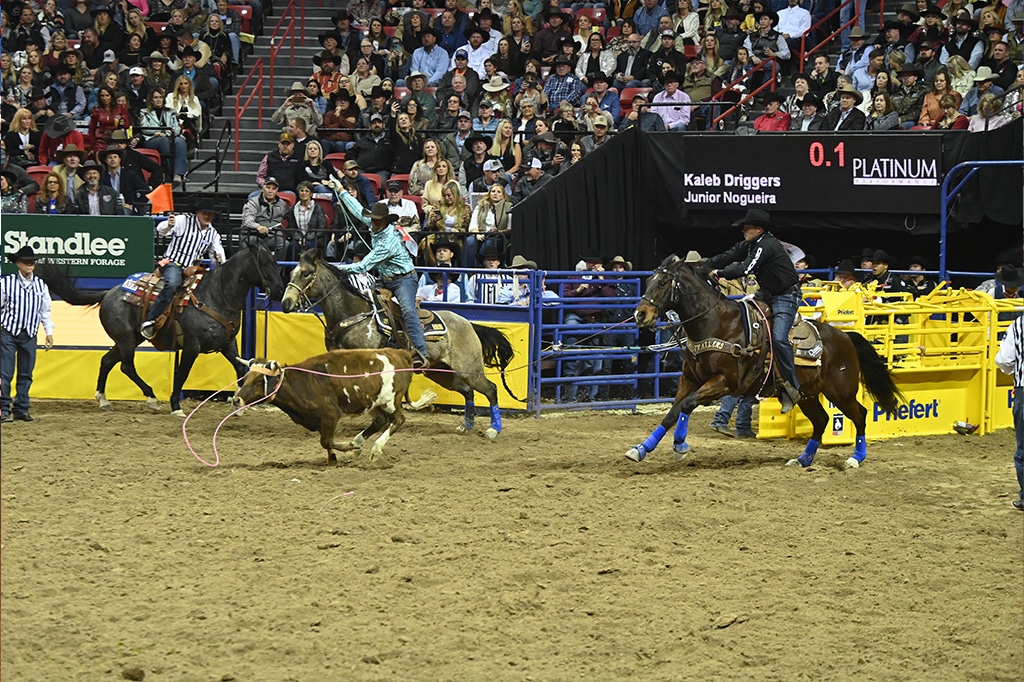For 10-time Wrangler National Finals Rodeo Qualifier Kaleb Driggers, knowing the right horse is underneath him in the roping box is key.
For as long as he can remember, Kaleb Driggers has had a rope in his hand. Growing up, he enjoyed gathering at one of several local roping arenas with his extended family and cousins, roping steers horseback and honing his skills on a pen full of goats. In his late teens, he joined forces with fellow roper Brad Culpepper and began competing in amateur rodeos before making his professional debut at the age of 18 and achieving an impressive 10 Wrangler NFR qualifications — and counting.
Driggers says a lifetime spent in rodeo has taught him many things — which rodeos to enter, how hard to push, and how to roll with the punches are among the lessons he’s learned out on the harrowing rodeo road. He’s also learned the importance of horsepower. A good horse is everything, Driggers says. And he doesn’t ever want to be caught without one.
Equinety: What do you look for in a top-tier rope horse?
KD: The first thing I look for is a horse that wants to score. The desire to score is a hard thing to teach a horse— usually they either want to or they don’t. I need something that’s easy to rope on. That sounds simple but the horse I’m on should make my job as easy as possible. Beyond that, I look for foot speed. They need to be able to run when I ask but stay easy for me to catch on. There are different strokes for different folks. Some people like longer strides while others like shorter strides, and there is no right or wrong when it comes to those kinds of preferences. At the end of the day, you need to be on the horse that matches your style.
Equinety: You’ve become a go-to guy for high-end rope horses. Why is it important to always be preparing for what’s next?
KD: A lot of times, people aren’t looking for a horse until they need one. I try to stay ahead of the curve and always have the next one ready. Earlier in my career, I had a really good horse die suddenly. That taught me how important it is to have the next one ready. It always seems like the hardest time to find a horse is when you need one the most, and that’s when you end up making a mistake. In my program, I’ll ride a horse for two or three months and if that horse doesn’t fit the bill, I’ll sell it to a cowboy or something like that. Once there’s a hole, there’s likely always going to be a hole. I won’t keep a horse like that on my trailer, and I won’t market it either.
Equinety: How do you keep your rope horses at the top of their game year-round?
KD: I treat horse care as an important part of my business model. Even if you go out and buy the best horse money can buy, you still have to know how to take care of that horse. Here’s a simple example: some people may get to the rodeo and may really need four bags of shavings for their stall, but think, ‘I can get by with two.’ Those people don’t realize when it comes time to compete, being comfortable and rested is going to give the horse an advantage. They think skimping one night won’t hurt a horse, but one night leads into two nights, and so on. It’s a mindset. Every little thing you can do to give your horse an advantage, you do it. The year is long, and the road is hard on them. Any chance I get to help them feel a little better is key. That’s really what led me to Equinety.
Equinety: What’s your best advice for someone who is considering making a living in rodeo?
KD: There’s no substitute for hard work. A lot of people out there are really talented, but they choose not to put in the work it takes to get to the next level or reach the goals they’ve set for themselves. Their goals may be very obtainable, but they won’t ever work hard enough to get there. I got up this morning and rode 5 or 6 colts. Then I went to the roping pen. I spent eight or nine total hours in the arena today. People see the glam and the glory and think, ‘I want to be there.’ Your dreams are achievable, but you have to be willing to work hard enough to see them come true.
Equinety: How were you introduced to Equinety?
KD: Danita Walker takes care of my good rope horse throughout the year, and she started him on Equinety. I’ve seen those results firsthand. It’s like a miracle worker — he can go from being a little sore and achy to being 95-100% when he’s on it, just feeling as good as he possibly can. It’s really been incredible.
Equinety: What would you tell someone who has never tried Equinety?
KD: Whatever it takes, I’m going to give my horses the best. I’ve seen my good rope horse go from not performing at 75% of his capability to turning right back around as soon as he’s on Equinety. At the 2022 Wrangler National Finals Rodeo, we ran out of Equinety, and he was without it for four days. As soon as we started him back on it, his hips got more fluid, he was feeling great and was ready to go. It was like magic.
